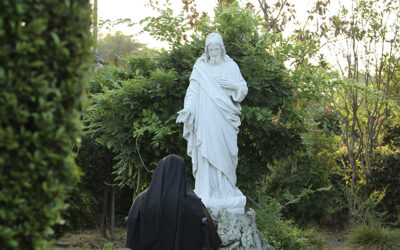Born in 1207, Elizabeth was the daughter of King Andrew II of Hungary and Gertrude of Andechs-Meran. At the age of four, Elizabeth was betrothed to Ludwig, the son of the Landgrave of Thuringia and taken to the Thuringian court in Wartburg, where she would be raised with her future husband. From a very early age, Elizabeth displayed great holiness and preferred to spend time in prayer and pious devotions rather than playing games with her playmates.
In 1221, the 14-year old Elizabeth and the 21-years old Ludwig were married, and unlike most arranged marriages, their union proved very happy and would produce three children. In 1223, Franciscan friars, sent by Saint Francis himself, arrived in Thuringia, and it is from them that Elizabeth learned about Saint Francis, and his charism of poverty and service.
Her heart was thus enflamed to perform even more acts of charity. Elizabeth helped the friars establish their monastery and made sure their needs were met. Encouraged by the friars in her acts of charity, Elizabeth began to spend monies from her own dowry in order to provide food and clothing for the poor and to establish hospitals to care for the sick. Although his relatives were less than pleased with Elizabeth’s charity, Ludwig fully supported and encouraged his wife in her endeavors, confident that such charitable actions were pleasing to and would be rewarded by God.
Several miracles are attributed to Saint Elizabeth during her lifetime – one being a “miracle of roses” which tells us that as Elizabeth was taking bread to the poor, she encountered her husband’s hunting party. In order to reassure his nobles that Elizabeth was not stealing from the royal stores, he asked her to reveal what was hidden under her cloak. As her cloak fell open, red and white roses cascaded out of the basket she held much to the astonishment of the nobles, but which to Ludwig only underscored that his wife’s actions were pleasing to God. Another miracle concerns Elizabeth caring for a leper in her and Ludwig’s bed. Horrified by this, Elizabeth’s mother-in-law quickly reported this to Ludwig, who upon going to see for himself, pulled back the covers and saw not a leper, but the crucified Christ stretched upon the bed.
Yet another miracle concerns grains during a time of severe famine. Elizabeth was very conscious of the fact the Landgrave’s silos were full to the brim, while his subjects had no food. Determined to alleviate the peoples’ suffering, Elizabeth ordered her bakers to take grain from the silos, and bake enough bread each day, which she would distribute among those in need. Again, some of Ludwig’s family opposed Elizabeth’s actions and complained to him that the grain was being used up and would soon leave the silos empty. Upon checking the stores, they were all astounded to find the silos filled to the brim with grain! No matter how much grain was used each day, the supply never depleted!
In 1227, Elizabeth’s life irrevocably changed when Ludwig died of typhoid en route to the Sixth Crusade. Upon learning the news of Ludwig’s death, Elizabeth deeply mourned him crying out: “The world with all its joys is now dead to me.” At this time, Ludwig’s brother took over the regency for Elizabeth’s five-year old son, and without her husband’s protection, Elizabeth endured even greater hostility from the Thuringian court. When bitter arguments ensued over the disposal of her dowry ensued, Elizabeth saw to it that her two little daughters were provided for, and then left Wartburg and moved to Marburg, although reports vary as to whether she left voluntarily or if she was driven out. After leaving the royal court, Elizabeth assumed the Franciscan religious habit, and made solemn vows of poverty, obedience and chastity to Konrad, Bishop of Marburg, whom the Pope appointed her spiritual director. At Marburg, Elizabeth would then spend the remaining four years of her life building hospitals for the sick, nursing the worst cases herself.
Elizabeth died in Marburg in 1231 at the age of 24, and almost immediately after her death, miracles of healing were reported as happening at her grave. She was canonized by Pope Gregory IV, just four years after her death. Saint Elizabeth’s feast day is November 17, and she is the patroness of the Third Order Franciscans, bakers, brides, widows, nursing homes, hospitals, nurses, charities and Third Order Franciscans.
Almighty God, by whose grace your servant Elizabeth of Hungary recognized and honored Jesus in the poor of this world: grant that we, following her example, may with love and gladness serve those in any need or trouble. In the name and for the sake of and through Jesus Christ our Lord, who lives and reigns with you and the Holy Spirit, one God, now and forever. Amen.




